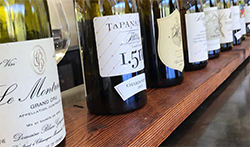Jacob’s Creek’s latest wine innovations
While Jacob’s Creek clearly has a fair way to go before matching Australia’s most innovative medium-to-large winery (Brown Brothers), I went to a tasting of some brand-new wines last week that reminded me, yet again, that JC really is an innovative producer (for a big company).
 Of course the only question, as with every innovative product, is simply whether these new wines will ‘work’. Or indeed if they’re needed in the first place.
Of course the only question, as with every innovative product, is simply whether these new wines will ‘work’. Or indeed if they’re needed in the first place.
For example, does a genre-hopping Sauvignon Blanc Moscato have what it takes to be a paradigm shifter?
I’m still not sure about the wines, but I do like what was the real focus of the tasting – to launch the new Jacob’s Creek logo (pictured).
At first glance, it looks a little simple. But a closer inspection and this logo is like a clever Magic Eye-esque stereogram, with all sorts of hidden symbolism going on – including the outline of a glass along the leaf midribs and a stylised version of Jacobs Creek in there too.
Will this logo sell more wine? Probably not, but it does help to contemporise a logo that hasn’t changed since the start of the brand in 1973.
If there was a wine to (potentially) spearhead Jacobs Creek 2.0, this new Jacob’s Creek Prosecco 2013 could be such a beast.
At this stage the wine is just a test release (circa 500 cases), with quantities limited by a short supply of Prosecco grapes (or Glera grapes if we’re following the Italian wishes) and largely a cellar door/on premise (restaurant) product.
 You could, however. argue that Prosecco has a huge capacity for growth as a quality dry sparkling that isn’t made with (costly) bottle fermentation, with the style overtaking Champagne sales in some markets.
You could, however. argue that Prosecco has a huge capacity for growth as a quality dry sparkling that isn’t made with (costly) bottle fermentation, with the style overtaking Champagne sales in some markets.
In some ways this wine – a Jacob’s Creek branded Prosecco – was bound to happen, particularly give just how much of a focus JC has on sparkling wine. But I didn’t expect to see one while the Prosecco branding issue is still up in the air.
The wine tasted better than expected too – It’s a simple Prosecco, no doubt, but not harsh, not overly sweet or broad. Pleasant drinking in other words (and better than a whole host of imported Prosecco in the sub $20 bracket).
I’m not sure that I’m the target market of this next wine, but I can absolutely understand the intention.
I mean, why not blend Sauvignon Blanc (the most popular white grape in Australia) with Moscato (the fastest growing style around)? Sure, Brown Brothers got their version out first, but JC aren’t far behind.
In fact, this Jacob’s Creek Twin Pickings Sauvignon Blanc Moscato 2013 has an equally on-trend Pinot Gris Moscato sister wine too, in a bid to wrap up the genre-blending category.
Clearly I’m not the target market here, but I can’t say I enjoyed this neutral sweet wine all that much. A little too sweet and cloying without the freshness to balance it out.
This final wine, however, had much more appeal going for it.
 Effectively a cellar-door only release, the Jacob’s Creek Earth Vine Grapes Shiraz 2012 is another release aiming to tap into consumer trends, in this case looking to capitalise on the raging demand for organic products.
Effectively a cellar-door only release, the Jacob’s Creek Earth Vine Grapes Shiraz 2012 is another release aiming to tap into consumer trends, in this case looking to capitalise on the raging demand for organic products.
As with the Prosecco, the limiting factor for this wine is all about supply, with certified organic grapes still rather hard to come by.
Arguably this is the least innovative wine of this trio, given that Yalumba has a successful budget organic range as do Angoves. It is notable, however, in the context of the export big brands (such as Wolf Blass, Yellowtail, Hardys etc) where organic wine is a distant second.
Happily this is a better wine too – a slightly boozy and weighty affair for the price (15% alcohol) but also perhaps filled out because of it. I’m not sure of the price, but if this was at a similar level to the Yalumba Shiraz you could call it fair buying.
Is it enough to really change things? Again probably not, but at the very least it is a wine to hold up as an example – a ‘umbrella wine’, that serves to highlight the green credentials of the whole Jacob’s Creek operation.
Would you buy it?
Help keep this site paywall free – donate here






Leave A Reply